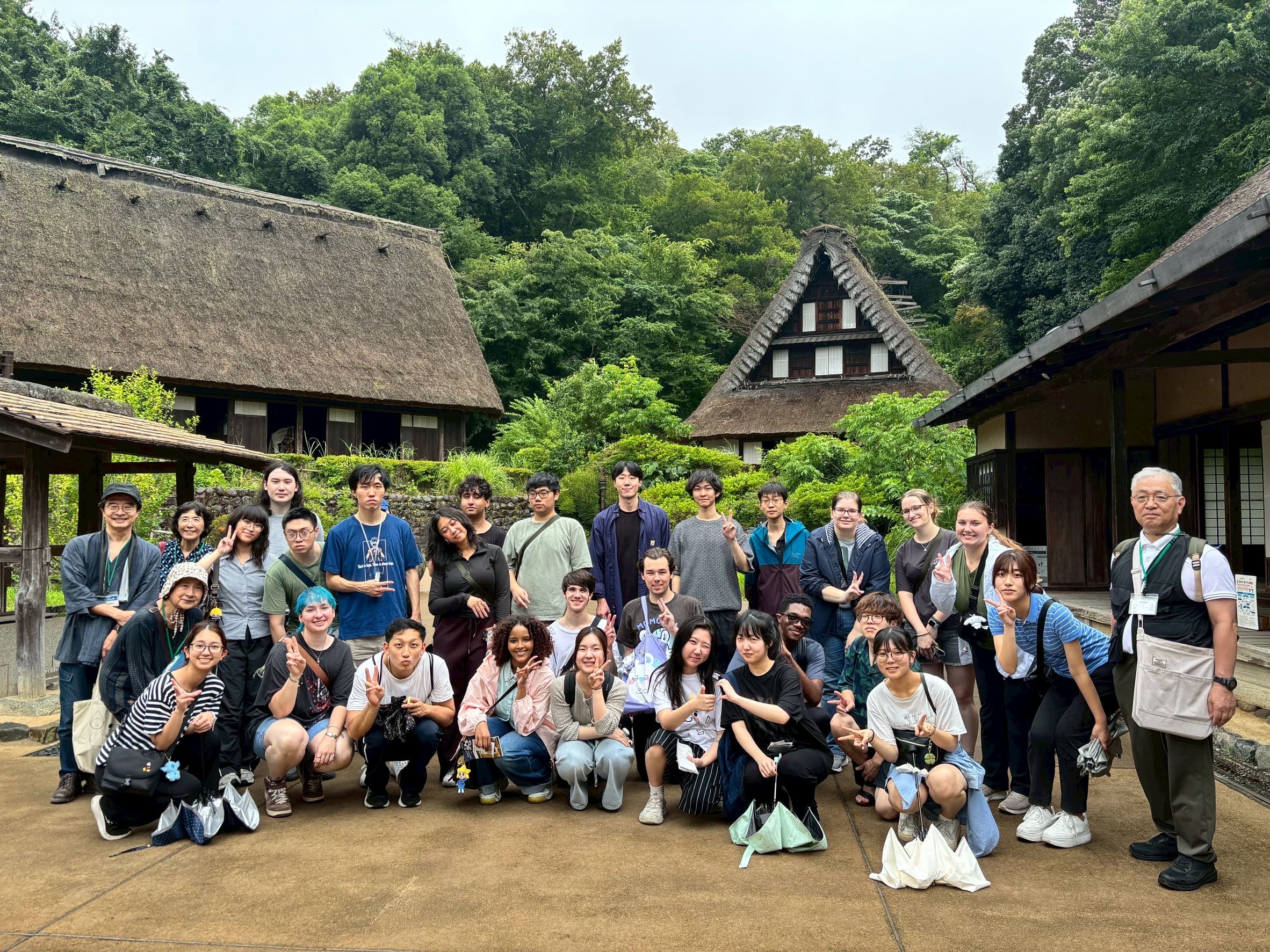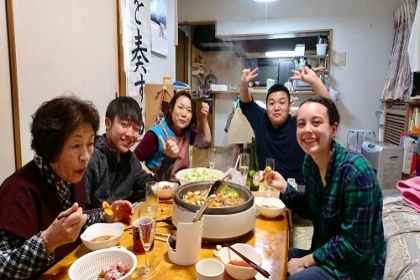Japanese Language and Culture Program
【Notice】
Schedule for 2026-2027 JLC Program has been posted now.
The 2026 leaflet and poster will also be updated.
If you have any questions or concerns, please contact us via the following email address:
E-mail:japanese(a)acc.senshu-u.ac.jp
*In order to avoid receiving spam emails, the above email address is purposely written using “(a)” instead of “@”. Therefore, we kindly ask that you replace “(a)” with “@” when sending an email to this address.
At Senshu University, you can take your first step toward connecting Japan with the world by learning both the language and its culture.
Even in a short period, students gain practical language skills and meaningful cultural insights. We invite you to deepen your understanding of Japan through Japanese—right here at Senshu University.
Schedule for 2026-2027 JLC Program has been posted now.
The 2026 leaflet and poster will also be updated.
If you have any questions or concerns, please contact us via the following email address:
E-mail:japanese(a)acc.senshu-u.ac.jp
*In order to avoid receiving spam emails, the above email address is purposely written using “(a)” instead of “@”. Therefore, we kindly ask that you replace “(a)” with “@” when sending an email to this address.
- JLC Program Leaflet (PDF)
- JLC Program Poster (PDF)
- The details of the program schedule can be found under "Schedule/Estimated Costs" in the pull-down list above.
- Application Process
For Those Who Want to Learn Japanese
Japanese is a fascinating language, rich in expression and deeply rooted in culture. Have you ever found yourself wanting to know more about Japan after experiencing its anime, manga, J-POP, traditional cuisine, or cultural heritage?At Senshu University, you can take your first step toward connecting Japan with the world by learning both the language and its culture.
Efficient Short-Term Learning of Japanese Language and Culture
Senshu University offers theJLC (Japanese Language and Culture) Program four times a year, designed specifically for international students. Classes are organized according to language proficiency, allowing students to develop balanced skills in reading, listening, speaking, and writing. In addition to language study, the program includes rich cultural experiences such as calligraphy and tea ceremony.Even in a short period, students gain practical language skills and meaningful cultural insights. We invite you to deepen your understanding of Japan through Japanese—right here at Senshu University.
<Recruiting Participants!>
Interested in studying Japanese language and Japanese culture in Japan?
How about joining in our program " Japanese Language and Culture Program"?
Practice your Japanese conversation skills with many chances getting in touch with Senshu students in and out of class. You will also experience Japanese culture as the activities held in the afternoon of weekday or weekends.
Details for the course is as follows;
Program Schedule
[Day & Time] Every Monday through Friday / 9:00am – 12:50pm < Japan Time >
Program Outline
[Eligible Students] Applicants who have completed 12 years of education
[Class Decision] Students will be placed in the appropriate class level based on the results of the placement test.
How about joining in our program " Japanese Language and Culture Program"?
Practice your Japanese conversation skills with many chances getting in touch with Senshu students in and out of class. You will also experience Japanese culture as the activities held in the afternoon of weekday or weekends.
Details for the course is as follows;
Program Schedule
[Day & Time] Every Monday through Friday / 9:00am – 12:50pm < Japan Time >
Program Outline
[Eligible Students] Applicants who have completed 12 years of education
[Class Decision] Students will be placed in the appropriate class level based on the results of the placement test.
Program Outline
Click on the boxes for more information about each Japanese class level.Prerequisites for the Japanese Language and Culture Program
Applicants must have completed 12 years of education or be a university student (or have equivalent qualifications) before applying.Purpose of the Japanese Language and Culture Program
This program aims to develop participants’ Japanese language proficiency and cultural competency via practical exercises/activities that foster language acquisition. Students will have opportunities to converse with Japanese students (“class visitors”) and give presentations in Japanese in order to improve their working knowledge of the language.Overview of Classes
To ensure that teachers are able to provide personal feedback to each student, the class sizes are purposely made small (maximum of 12 students). Class size is subject to change depending on the results of the online Japanese Comprehension Checklists.*The minimum number of students for each class is 6. If the number of students is less than 6, the class for that level will not be offered.
Class Style
9:00 a.m. – 12:50 p.m. (four periods composed of four successive 50 minute sessions)Monday through Friday.
Activities and Cultural Lessons
The following activities are scheduled for certain afternoons during the program and are subject to change depending on the term.
• Tokyo National Museum
• Kabuki plays
• Noh theater
• Japanese calligraphy
• One-day trip to Kamakura (large statue of Buddha)
• Tea Ceremony
• Virtual earthquake simulator (Summer term only)
• Overnight trip to Hakone (Fall term only)
• Origami class(Winter term only)
• Tokyo National Museum
• Kabuki plays
• Noh theater
• Japanese calligraphy
• One-day trip to Kamakura (large statue of Buddha)
• Tea Ceremony
• Virtual earthquake simulator (Summer term only)
• Overnight trip to Hakone (Fall term only)
• Origami class(Winter term only)

Three-day Home Visit Program (Optional)
Participants in the JLC Program have the option of experiencing a three-day home visit with a Japanese family for one-weekend(excluding summer 1 term course). Students who wish to participate must pay an additional fee.
Suitable host families are actively recruited with home visits arranged according to availability.
Click here for more.
Suitable host families are actively recruited with home visits arranged according to availability.
Click here for more.

Japanese Comprehension Checklist
Upon completing the online application form, applicants will be directed to complete an online Comprehension Checklist. The purpose of this checklist is to assess applicants’ current level of Japanese. Please fill out this checklist without using any dictionaries or other outside assistance. Upon your arrival in Japan, you will be given a final oral and written test to ensure you are placed in the appropriate class level. For more details, please see the "class level".Please note that if there are less than six applicants for a certain class level based on the results of the online Comprehension Checklist, that class level may not be available.
Supplementary Language
Should a supplementary language be necessary for explanation during the Japanese Class, English will be the only other language used.Completion Certificates and Grade Reports
Certificates and Grade Reports are given to those who satisfactorily complete the required program tasks and assignments.EXAMPLE CLASS LEVELS (12-Week Fall Term Course)
J1A [Introductory Level]
Applicants are requested to learn Hiragana (one of the Japanese alphabets) prior to participating in the program.| Objectives | ・To be able to participate in simple daily conversation, and talk about oneself and one’s country of origin ・To deepen one’s understanding of Japanese culture |
Class Content | ・Introductory level grammar points ・Simple daily conversation and listening ・Reading and writing simple sentences and paragraphs ・Hiragana and Katakana (Japanese alphabets), and basic pronunciation ・Basic vocabulary and 100 Kanji characters ・Presentation ・Understanding Japanese culture |
Teaching Materials | ・Daichi I (3A Corporation) Lesson 1–19 ・Hiragana and Katakana Practice Workbook (original) ・Combined Grammar Listening Elementary 1 (3A Corporation) Lesson 1–19 ・Minna no Nihongo Shokyu I Kanji (3A Corporation) Unit 1–9 |
| Note | The content of each class can be adjusted according to the level of applicants. |
J1B[Beginner Level]
| Objectives | ・To be able to engage in basic daily conversation, and talk about familiar topics ・To deepen one’s understanding of Japanese culture |
Class Content | ・Lower beginner level grammar points ・Basic daily conversation and listening ・Reading and writing simple paragraphs ・Basic vocabulary and 160 Kanji characters ・Presentation ・Understanding Japanese culture |
Teaching Materials | ・Daichi I (3A Corporation) Lesson 14 –22 ・Daichi II (3A Corporation) Lesson 23–28 ・Combined Grammar Listening Elementary 1 (3A Corporation) Lesson 14–22 ・Combined Grammar Listening Elementary 2 (3A Corporation) Lesson 23–28 ・Basic Kanji Book Vol.1 (Bonjinsha) Lesson 8–20 |
| Note | The content of each class can be adjusted according to the level of applicants. |
J1C[Upper Beginner Level]
| Objectives | ・To be able to engage in basic daily conversation, and talk about familiar topics ・To deepen one’s understanding of Japanese culture |
Class Content | ・Upper beginner level grammar points ・Basic daily conversation and listening ・Reading and writing simple paragraphs ・Basic vocabulary and 160 Kanji characters ・Presentation ・Understanding Japanese culture |
Teaching Materials | ・Daichi II (3A Corporation) Lesson 23–38 ・Combined Grammar Listening Elementary 2 (3A Corporation) Lesson 23–38 ・Basic Kanji Book Vol. 2 (Bonjinsha) Lesson 23–36 *Spring Course: Situational Spoken Japanese (Senshu original) |
| Note | The content of each class can be adjusted according to the level of applicants. |
J2 [Lower Intermediate Level]
| Objectives | ・To be able to discuss familiar issues, and express one’s opinion ・To deepen one’s understanding of Japanese culture |
Class Content | ・Reinforcement of basic grammar points, and lower intermediate level grammar points ・Daily conversation and listening ・Reading and writing slightly longer paragraphs ・Pronunciation, vocabulary, and 160 Kanji characters ・Simple research presentation ・Understanding Japanese culture |
Teaching Materials | ・Comprehensive Japanese Practice through Specific Topics– Lower Intermediate (3A Corporation) ・Understanding and Using Japanese (3A Corporation) ・Basic Kanji Book Vol. 2 (Bonjinsha) Lesson 30–42 *Spring Course: Situational Spoken Japanese (Senshu original) |
| Note | The content of each class can be adjusted according to the level of applicants. |
J3 [Intermediate Level]
| Objectives | ・To be able to summarize and express one's ideas and opinions ・To deepen one’s understanding of Japanese culture |
Class Content | ・Intermediate level grammar points and expressions ・Expressing one's ideas and opinions ・Listening to slightly longer narration and conversation ・Reading and writing slightly more sophisticated paragraphs ・Pronunciation, vocabulary, and 200 Kanji characters ・Research presentation ・Understanding Japanese culture |
Teaching Materials | ・Comprehensive Japanese Practice through Specific Topics –Upper Intermediate (3A Corporation) ・Skill-based textbooks ・Japanese for International College/Graduate Students: kanji and vocabulary (Aruku) About 10 lessons from Lesson 1–21 *Spring Course: Functional Spoken Japanese (Senshu original) |
| Note | The content of each class can be adjusted according to the level of applicants. |
J4 [Advanced Level]
| Objectives | ・To be able to summarize simple news and articles, and express one's opinions logically ・To deepen one’s understanding of Japanese culture |
Class Content | ・Advanced Level grammar points and expressions ・Pronunciation and expressions for smooth communication ・Listening to simple news, reading simple articles, and exchanging the information from the materials ・Academic writing ・Vocabulary and 200 Kanji characters ・Research presentation ・Understanding Japanese culture |
Teaching Materials | ・Comprehensive Japanese Practice through Specific Topics– Advanced(3A Corporation) ・Skill-based textbooks ・Authentic materials (i.e. simple news and articles) ・Japanese for International College/Graduate Students: kanji and vocabulary (Aruku) About 10 lessons from Lesson 15–27 *Spring Course: Japanese Conversation (Senshu original) |
| Note | The content of each class can be adjusted according to the level of applicants. |
J5 [Upper Advanced Level]
| Objectives | ・To be able to summarize news and articles without difficulty in any given situation, and express one's opinions logically ・To deepen one’s understanding of Japanese culture |
Class Content | ・Upper advanced Level grammar points and expressions ・Expanding one's knowledge of pronunciation and expressions for smooth communication ・Listening to news, reading articles, and exchanging the information from the materials ・Academic writing ・Vocabulary and 200 Kanji characters ・Research presentation ・Understanding Japanese culture |
Teaching Materials | ・Comprehensive Japanese Practice through Specific Topics (Senshu original) ・Skill-based textbooks ・Authentic materials (i.e. news and articles) ・Japanese for International College/Graduate Students: kanji and vocabulary (Aruku) About 10 lessons from Lesson 28–40 |
| Note | The content of each class can be adjusted according to the level of applicants. |